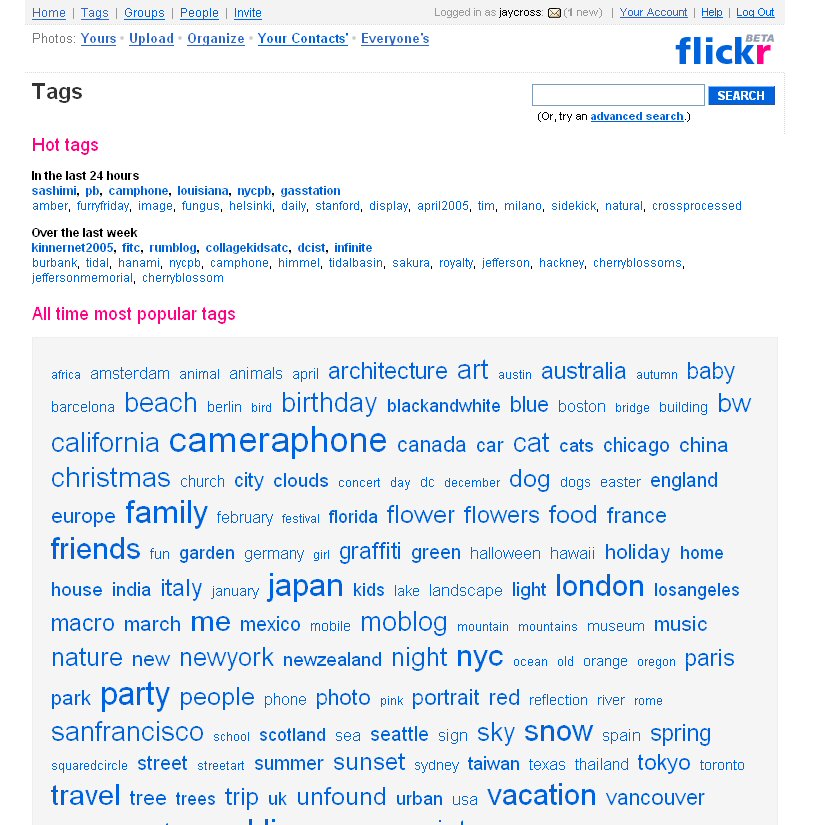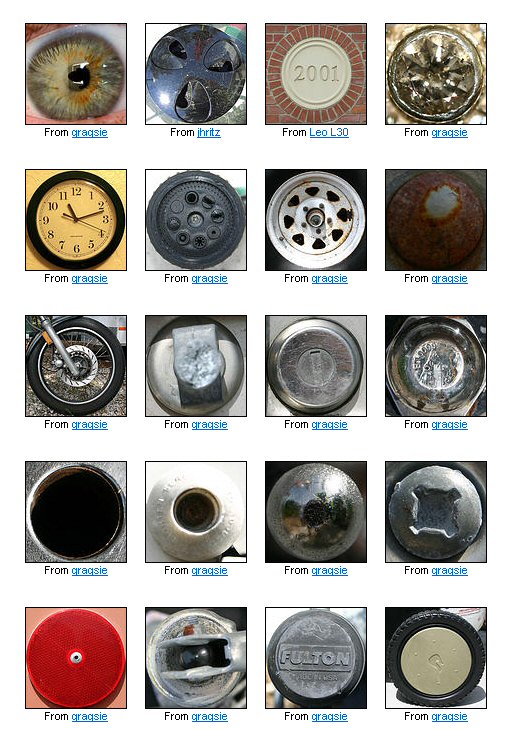Friday, April 15, 2005
Tagging
from Newsweek's Steven Levy
Think of tagging as the opposite of search. By leaving linguistic bread crumbs behind on your wanderings through cyberspace, you can easily relocate the sights (and sites) you saw along the way.
But "keeping found things found"—as Clay Shirky, a teacher at NYU's Interactive Telecommunications Program, explains—is only the first benefit of a grass-roots tagging system. Whereas the old, Dewey-style taxonomies involved graybeards figuring out in advance how things should be categorized, tagging is done on the fly, adapting to the content itself. What's more, because all this is digital, there's no limit to the number of tags people can slap on an item.
Think of the process as similar to that of language, which is also a self-organized process," says author and tagging proponent David Weinberger. That process is also at work on a Web site called 43 Things, where people express their goals, tag them and comment and commiserate on the goals of others.
Flckr, 43 Things, Delicious, Technorati
del.icio.us
del.ico.us calls itself a social bookmarking service. with the delicious toolbar running in your browser, you can add a tag to any page on the web. on the fly. thousands of people are doing this, making up their own tags or selecting tags from a list. this is totally informal and unstructured. in fact, users call these bodies of tags folksonomies or tagsonomies to distinguish them from pre-arranged taxonomies.
Creating ad hoc tags is but one side of the equation. Consuming them is where the power of the hive comes in. This is the social part. del.icio.us and similar services. You can troll popular tags or search among favorites. Just this moment I called up Zniff, a service that scans tags from Spurl (another online bookmarking service). Before I knew it, I was browsing through page after page of fascinating material on learning ecologies.

Flickr shows what tags are popular on recent photographs. Click a tag, see a slideshow of all photos submitted with that tag. For example, clicking squaredcircle finds 11,748 photographs so tagged. Thumbnails appear on 588 pages of 20 each. I enjoy looking over them as a slide show.

Instructional design is the process through which an educator determines the best teaching methods for specific learners in a specific context, attempting to obtain a specific goal.
Think of tagging as the opposite of search. By leaving linguistic bread crumbs behind on your wanderings through cyberspace, you can easily relocate the sights (and sites) you saw along the way.
But "keeping found things found"—as Clay Shirky, a teacher at NYU's Interactive Telecommunications Program, explains—is only the first benefit of a grass-roots tagging system. Whereas the old, Dewey-style taxonomies involved graybeards figuring out in advance how things should be categorized, tagging is done on the fly, adapting to the content itself. What's more, because all this is digital, there's no limit to the number of tags people can slap on an item.
Think of the process as similar to that of language, which is also a self-organized process," says author and tagging proponent David Weinberger. That process is also at work on a Web site called 43 Things, where people express their goals, tag them and comment and commiserate on the goals of others.
Flckr, 43 Things, Delicious, Technorati
I can’t imagine that I would stop learning! Not only do I learn whatever comes along my way, I seek out learning daily. I’m moving this to my “Done” list!
I can’t imagine that I stop learning for my whole life! I always learn – just looking, listening and feeling everything around me. And I do thousands of things (sometimes too much!), actually I am learning spanish (2nd course), playing cembe, singing opera arias, designing an internet page without tables, working with iTunes, develop myself, and many other things more…
I really feel like its uber-important in life to keep your brain active with new experiences. Right now I’m re-reading American history textbooks, getting ready for law school, and hoping to try to train for a half-marathon. I’m also reading Sophie’s World to learn some basics of Philosophy.
I’m taking japanese and excel classes, I started reading the Finantial Times’ Weekend, plus I’m tring to improve my listening skills!
Study for the MBA, specialize in a medical field like Paeds, learn how to ride a bicycle, learn to play the drums… (to be continued)
del.icio.us
del.ico.us calls itself a social bookmarking service. with the delicious toolbar running in your browser, you can add a tag to any page on the web. on the fly. thousands of people are doing this, making up their own tags or selecting tags from a list. this is totally informal and unstructured. in fact, users call these bodies of tags folksonomies or tagsonomies to distinguish them from pre-arranged taxonomies.
Creating ad hoc tags is but one side of the equation. Consuming them is where the power of the hive comes in. This is the social part. del.icio.us and similar services. You can troll popular tags or search among favorites. Just this moment I called up Zniff, a service that scans tags from Spurl (another online bookmarking service). Before I knew it, I was browsing through page after page of fascinating material on learning ecologies.
Social Bookmarking Tools (I)
A General Review
We are here going to remind you of hyperlinks in all their glory, sell you on the idea of bookmarking hyperlinks, point you at other folks who are doing the same, and tell you why this is a good thing. Just as long as those hyperlinks (or let's call them plain old links) are managed, tagged, commented upon, and published onto the Web, they represent a user's own personal library placed on public record, which – when aggregated with other personal libraries – allows for rich, social networking opportunities. Why spill any ink (digital or not) in rewriting what someone else has already written about instead of just pointing at the original story and adding the merest of titles, descriptions and tags for future reference? More importantly, why not make these personal 'link playlists' available to oneself and to others from whatever browser or computer one happens to be using at the time?

Flickr shows what tags are popular on recent photographs. Click a tag, see a slideshow of all photos submitted with that tag. For example, clicking squaredcircle finds 11,748 photographs so tagged. Thumbnails appear on 588 pages of 20 each. I enjoy looking over them as a slide show.

Instructional design is the process through which an educator determines the best teaching methods for specific learners in a specific context, attempting to obtain a specific goal.
